hi all, This blog is created by Ro8 ANE students of MNR college of engineering and technology, cheer up aerozzz .. join all your wings i.e hands to fly higher and higher in this field. we welcome all .. Thank you, Team-AEROzzz....
Monday, December 19, 2011
Saturday, December 17, 2011
Raymer-aircraft design-a conceptual approach
link :
http://aeroden.files.wordpress.com/2010/12/84632___raymer_-_aircraft_design_-_a_conceptual_approach.pdf
all the best for SADD .....:(
http://aeroden.files.wordpress.com/2010/12/84632___raymer_-_aircraft_design_-_a_conceptual_approach.pdf
all the best for SADD .....:(
Thursday, December 8, 2011
VSD - grehem kelly .... :)
http://aeroden.files.wordpress.com/2011/08/schaum__039_s_outline_of_mechanical_vibrations.pdf
click on above link for book - good for basics :
click on above link for book - good for basics :
Wednesday, December 7, 2011
VSD - SS RAO .... :)
vibrations ... subjects creating vibrations in and out ...
here is text book for VSD ..
link :http://www.ziddu.com/download/17723355/51092484-Mechanical-Vibrations-by-s-s-RAo-ebook2.pdf.html
good luck ... :) ..
here is text book for VSD ..
link :http://www.ziddu.com/download/17723355/51092484-Mechanical-Vibrations-by-s-s-RAo-ebook2.pdf.html
good luck ... :) ..
computational-fluid-dynamics-vol-ii-hoffmann
exams .. exams ... exams ... starting nite outs ???
start following blog for regular updates of important materials again ... here is book for uncovered topics from CFD anderson .. specially grid generation .,
http://www.ziddu.com/download/17723271/computational-fluid-dynamics-vol-ii-hoffmann.pdf.html
good luck aerozzz ...:)
start following blog for regular updates of important materials again ... here is book for uncovered topics from CFD anderson .. specially grid generation .,
http://www.ziddu.com/download/17723271/computational-fluid-dynamics-vol-ii-hoffmann.pdf.html
good luck aerozzz ...:)
Wednesday, August 31, 2011
Tuesday, August 30, 2011
PLACEMENT MATERIAL --- very important
Good morning AErozzz .... this is link for placement material, it is really useful for placement patterns of various MNCs , and tips for resume preparation , interview guidance .......have glance
download link :
http://www.ziddu.com/download/16242191/placement_material.doc.html

All the best for final battle ( interviews) .....
Thank you . ;>))
Saturday, August 27, 2011
"Adverse yaw" and how to solve it ?????????
To understand what adverse yaw is, we need to first explain the axes of motion for an airplane. An aircraft in flight can rotate around three different axes, as illustrated below.

Aircraft axes of motion

Aircraft control surfaces
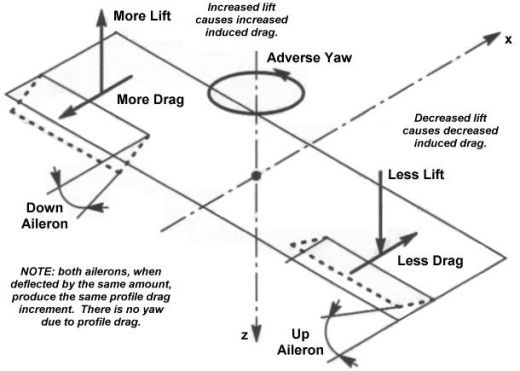
Effects caused by aileron deflection
Unfortunately, drag is also affected by this aileron deflection. More specifically, two types of drag, called induced drag and profile drag, are increased when ailerons are deployed. Induced drag is a form of drag that is induced by any surface that generates lift. The more lift a surface produces the more induced drag it will cause (for a given wingspan and wing area). Thus, the wing on which the aileron is deflected downward to generate more lift also experiences more induced drag than the other wing. Profile drag includes all other forms of drag generated by the wing, primarliy skin friction and pressure drag. This profile drag increases on both wings when the ailerons are deflected, but the increase is equal when the ailerons are deflected by the same amount. However, the induced drag on each side is not equal, and a larger total drag force exists on the wing with the down aileron. This difference in drag creates a yawing motion in the opposite direction of the roll. Since the yaw motion partially counteracts the desired roll motion, we call this effect adverse yaw.
We can correct for this effect in several ways, the most important methods being:

Aircraft axes of motion

Aircraft control surfaces

Effects caused by aileron deflection
Unfortunately, drag is also affected by this aileron deflection. More specifically, two types of drag, called induced drag and profile drag, are increased when ailerons are deployed. Induced drag is a form of drag that is induced by any surface that generates lift. The more lift a surface produces the more induced drag it will cause (for a given wingspan and wing area). Thus, the wing on which the aileron is deflected downward to generate more lift also experiences more induced drag than the other wing. Profile drag includes all other forms of drag generated by the wing, primarliy skin friction and pressure drag. This profile drag increases on both wings when the ailerons are deflected, but the increase is equal when the ailerons are deflected by the same amount. However, the induced drag on each side is not equal, and a larger total drag force exists on the wing with the down aileron. This difference in drag creates a yawing motion in the opposite direction of the roll. Since the yaw motion partially counteracts the desired roll motion, we call this effect adverse yaw.
We can correct for this effect in several ways, the most important methods being:
- Frise ailerons: The concept behind this particular kind of aileron is to minimize the profile drag on the wing with the down aileron while increasing the profile drag on the wing with the up aileron. This difference in profile drag counteracts the effect of induced drag thereby creating a yawing motion that at least partially cancels the adverse yaw effect.
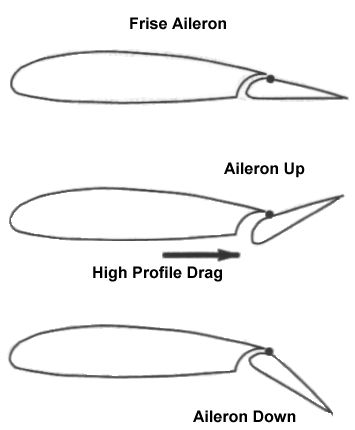
Frise ailerons - Differential ailerons: Another approach to solving adverse yaw is to deflect the ailerons by differing amounts. The deflection of the down aileron is typically much less than the up aileron so that the additional profile drag is very small compared to that on the up aileron.

Differential ailerons - Spoilers: Spoilers are long narrow flat plates typically fitted along the upper surface of both wings. In normal flight, spoilers lie flat and generate no effect on the aerodynamic performance of the wing. However, the spoilers can be raised upward into the air flow to generate large turbulence that reduces the lift and increases the drag on a wing.
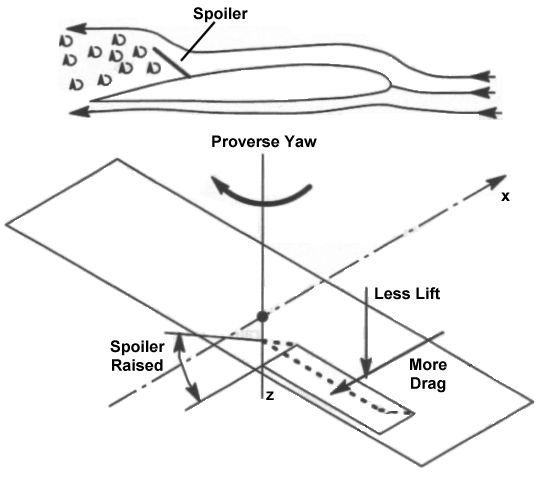
Spoiler - Cross-coupled controls: One of the most effective solutions to adverse yaw is to couple the ailerons and rudder so that both surfaces deflect simulataneoulsy. As the ailerons create a yaw motion in one direction, the rudder automatically deflects to create a yaw motion in the opposite direction. The two effects counteract each other eliminating the undesired yaw. This form of cross-coupling was often built into the cable-and-pulley control systems of older aircraft. The problem was recognized even as early as the Wright brothers who incorporated such controls into the Wright Flyer. In addition, most major aircraft today utilize some sort of computerized fly-by-wire control system, and it is rather trivial to program cross-coupled control measures into the automated systems.
Wednesday, August 3, 2011
How do helicopters without tail rotors, like the V-22 and Ka-50, counter the torque effect? How are they able to spin on the spot?
Both of the aircrafts mentioned are equipped with two rotors. The V-22 Osprey has one rotor mounted on each wing tip and the Ka-50 Hokum has two mounted on the same shaft. In both cases, the two rotors rotate in opposite directions. As we know about torque effect, counter-rotating propellers and rotors generate opposing torques that cancel each other out.
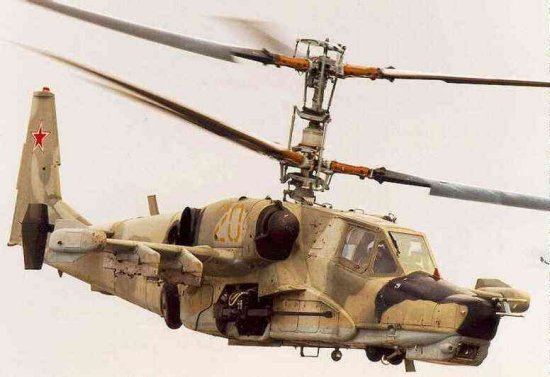
Ka-50 with coaxial rotors
The second part of question has to do with rotor dynamics. You may not realize it, but helicopter rotors are designed to move in more ways than just rotation about the central hub. The individual blades are also able to rotate or pitch up and down so they meet the air at higher or lower angles of attack. This change in blade pitch is accomplished in two ways. The first, calledcollective, allows the pilot to change the pitch of all blades simultaneously. At takeoff, for example, the pitch of all blades is increased until the rotor produces enough lift to exceed the weight of the helicopter. Thus, collective is used to change a helicopter's altitude
A second method of changing the rotor blade pitch is called cyclic. This control allows the pilot to change each blade's pitch angle independently. By doing so, a traditional helicopter can be made to roll or to move in a particular direction. The cyclic lever works much like the control stick or yolk on an airplane. For example, pushing the lever forward causes the helicopter to move forward. This motion occurs because the control stick deflection forces the forward-moving (advancing) blades to pitch to a lower angle of attack and the backward-moving (retreating) blades to pitch to a higher angle of attack. As a result, the entire rotor is tilted down towards the heliopter nose. This causes the lift vector to tilt forward creating a thrust component that moves the helicopter forward. Similarly, pulling the stick back moves the helicopter backward, moving it left moves the helicopter to the left, and so on.
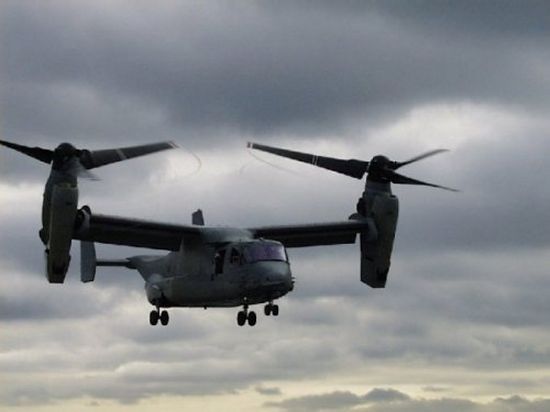
V-22 with twin non-coaxial rotors
However, question relates to yaw control, or the ability of a helicopter to turn left or right. Most helicopters accomplish yaw control using the small tail rotor. By changing the pitch of the tail rotor's blades, this rotor will produce a side force that turns the helicopter nose left or right. Since neither the V-22 nor the Ka-50 have a tail rotor, how are they able to yaw? They do so using the cyclic. If a helicopter has two rotors, it can tilt one as if to move to the left and another as if to move to the right, but the combined effect causes the helicopter to spin while hovering over the same spot. This scenario explains how both the V-22 and Ka-50 are able to yaw while in hover. Tandem rotor helicopters, like the CH-47 Chinook, and intermeshing rotor helicopters, like the Kaman K-MAX, also rely on differential rotor cyclic to provide yaw control.

Ka-50 with coaxial rotors
The second part of question has to do with rotor dynamics. You may not realize it, but helicopter rotors are designed to move in more ways than just rotation about the central hub. The individual blades are also able to rotate or pitch up and down so they meet the air at higher or lower angles of attack. This change in blade pitch is accomplished in two ways. The first, calledcollective, allows the pilot to change the pitch of all blades simultaneously. At takeoff, for example, the pitch of all blades is increased until the rotor produces enough lift to exceed the weight of the helicopter. Thus, collective is used to change a helicopter's altitude
A second method of changing the rotor blade pitch is called cyclic. This control allows the pilot to change each blade's pitch angle independently. By doing so, a traditional helicopter can be made to roll or to move in a particular direction. The cyclic lever works much like the control stick or yolk on an airplane. For example, pushing the lever forward causes the helicopter to move forward. This motion occurs because the control stick deflection forces the forward-moving (advancing) blades to pitch to a lower angle of attack and the backward-moving (retreating) blades to pitch to a higher angle of attack. As a result, the entire rotor is tilted down towards the heliopter nose. This causes the lift vector to tilt forward creating a thrust component that moves the helicopter forward. Similarly, pulling the stick back moves the helicopter backward, moving it left moves the helicopter to the left, and so on.

V-22 with twin non-coaxial rotors
However, question relates to yaw control, or the ability of a helicopter to turn left or right. Most helicopters accomplish yaw control using the small tail rotor. By changing the pitch of the tail rotor's blades, this rotor will produce a side force that turns the helicopter nose left or right. Since neither the V-22 nor the Ka-50 have a tail rotor, how are they able to yaw? They do so using the cyclic. If a helicopter has two rotors, it can tilt one as if to move to the left and another as if to move to the right, but the combined effect causes the helicopter to spin while hovering over the same spot. This scenario explains how both the V-22 and Ka-50 are able to yaw while in hover. Tandem rotor helicopters, like the CH-47 Chinook, and intermeshing rotor helicopters, like the Kaman K-MAX, also rely on differential rotor cyclic to provide yaw control.
Friday, July 29, 2011
Thread For Aeronautical Students [Text Books ] - Jntu World
http://forum.jntuworld.com/showthread.php?2938-Thread-For-Aeronautical-Students-Text-Book
many useful books in above thread ... hava a glance ....;>))
team AeroZzZz......
COMPUTATIONAL AERODYNAMICS - ANDERSON
HI all .....
new beginning - new possibilities ..... yes ..... i m talking about our college ......
its going great ... and let us try to maximize our effort in last academic year @ COLLEGE....
link for text book ( CFD - ANDERSON ) :
http://www.ziddu.com/download/15866976/cfd.pdf.html
ALL THE BEST
new beginning - new possibilities ..... yes ..... i m talking about our college ......
its going great ... and let us try to maximize our effort in last academic year @ COLLEGE....
link for text book ( CFD - ANDERSON ) :
http://www.ziddu.com/download/15866976/cfd.pdf.html
ALL THE BEST
Friday, April 8, 2011
dynamics of flight by etikins ..;>)
dynamics of flight by etikins ..... covers basics ..... flight mechanics .....
lots of bla bla to study .....
download link :
http://www.ziddu.com/download/14517571/dynamics_of_flight_by_etkins.pdf.html.
;>)))
happy preparation ........
lots of bla bla to study .....
download link :
http://www.ziddu.com/download/14517571/dynamics_of_flight_by_etkins.pdf.html.
;>)))
happy preparation ........
Analysis and Design of Flight Vehicles Structures, Bruhn ....... **important **
xams xams ..... sounds hard to listen ... still , ...
need to study ..;>)
http://www.ziddu.com/download/14517378/Analysis_and_Design_of_Flight_Vehicles_Structures_Bruhn.pdf.html
very good buk ..;>)
cheers and happy preparation all ......;>)
by -- vissu30,
team aerozz ....
need to study ..;>)
http://www.ziddu.com/download/14517378/Analysis_and_Design_of_Flight_Vehicles_Structures_Bruhn.pdf.html
very good buk ..;>)
cheers and happy preparation all ......;>)
by -- vissu30,
team aerozz ....
Tuesday, April 5, 2011
attention ... change in lab exam dates , and procedure
attention aerozz ...
lab exam postponed to 08-04-2011 ......
exam begins at 9 am , and no need of c program , excel sheet pakka ....
exam pattern :
FVD - excel sheet , written test , viva voce
AVS - written test , viva voce .......
good luck all ..... keep chimping books ....
------------------------------------------------------------------------------------------------------------
lab exam postponed to 08-04-2011 ......
exam begins at 9 am , and no need of c program , excel sheet pakka ....
exam pattern :
FVD - excel sheet , written test , viva voce
AVS - written test , viva voce .......
good luck all ..... keep chimping books ....
------------------------------------------------------------------------------------------------------------
Sunday, March 27, 2011
important questions for AP2 :: 4-8 units
AEROSPACEPROPULSION -II
1) . Identify the components of a solid propellant rocket motors with a sketch. Explain
briey the components.
2) What are the characteristics of liquid propellants and the types of liquid propellants.
Give the examples of each.
3) write short notes on :
(a) Photon propulsion
(b) Free radical propulsion
(c) Nuclear fusion
(d) Problems associated with plasma jet propulsion.
4) Discuss the advantages and disadvantages of scramjet.
5) Compare the solid propulsion systems with liquid propulsion systems and mention
their comparative advantages and usage.
6)
(a) Explain the following with respect to a rocket motor:
i. Impulse to weight ratio
ii. Total impulse.
(b) Di_erentiate between a rocket and a missile..
-------------------------------------------------------------------------------------------------------------all the best aerozzz...
Subscribe to:
Comments (Atom)